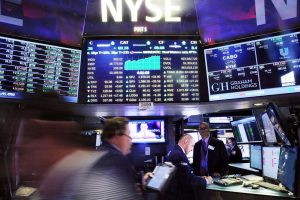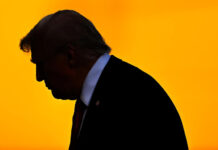MARCH 11, 2020

New York Stock Exchange NYSE MKTZ – Spencer Platt / Getty Images
The coronavirus-induced sell-off reached a new low Wednesday as Wall Street grappled with the rapid spread of the virus as well as uncertainty around a fiscal response to curb slower economic growth from the outbreak.
The Dow Jones Industrial Average tumbled 1,464 points, or nearly 5.9%. The 30-stock average closed more than 20% below its record high set last month. A 20% decline is considered a bear market on Wall Street. However, most investors don’t recognize it officially until the index does it on a closing basis. The Dow did so on Wednesday, whereas the S&P 500 finished just above that closing threshold.
The S&P 500 is more than 19% from its closing record and ended the day 4.9% lower. The Nasdaq fell 4.7% and also is about 19% below its all-time high.
“We can see the panic in the equity market,” said Jerry Braakman, an investment officer of First American Trust. “The big question for most people is, are we at the bottom yet? I think we’re only about halfway there.”
The World Health Organization declared Wednesday the outbreak a global pandemic. The number of coronavirus cases around the world totaled more than 100,000, according to data from Johns Hopkins University. In the U.S. alone, more than 1,000 cases have been confirmed. This increase in cases added to fears of a global economic slowdown and have increased calls for government intervention.
President Donald Trump suggested Tuesday a 0% payroll tax rate that could last until the end of the year. However, the timing of such policies being implemented remains uncertain. Sen. Chuck Grassley, who heads the Senate Finance Committee, said such a tax cut needed to be examined.
“Markets seem disappointed that the White House did not release details of its fiscal response to the coronavirus,” said Brian Gardner, a Washington policy analyst at KBW. “We are still in early days and policymakers are continuing to grapple with different options and negotiate between the two parties and between Congress and the administration.”
Central banks have also acted to curb slower economic growth. The Bank of England on Wednesday cut its benchmark rate by 50 basis points to 0.25%. The Federal Reserve also increased the amount of money it is providing to banks through overnight repo lending to $175 billion.
The uncertainty around fiscal stimulus, coupled with a reduction in travel demand and rising coronavirus cases, pressured airline and cruise line stocks. American, Delta, United and JetBlue all fell at least 6.5%. Norwegian Cruise Line and Carnival fell 20.4% and 12.4%, respectively.
“We need to see meaningful support for economic activity and credit backstops especially for small businesses, not a targeted approach executed only by the executive branch,” Joe Kalish, a global macro strategist at Ned Davis Research, said in a note. “We will likely need congressional involvement. This is a potential solvency problem.”
Wednesday’s moves came after the major averages posted sharp gains in the previous session. The Dow rallied more than 1,100 points while the S&P 500 had its best one-day performance since Dec. 26, 2018.
“Stocks posted impressive headline gains, but more strength needs to be seen beneath the surface to have confidence that the downside momentum in stocks has been broken,” Willie Delwiche, investment strategist at Baird, said in a note. “The weight of the evidence continues to argue for caution in the near term and we recommend that investors remain patient in the face of ongoing market volatility.”
Courtesy/Source: AP/CNBC







































































































